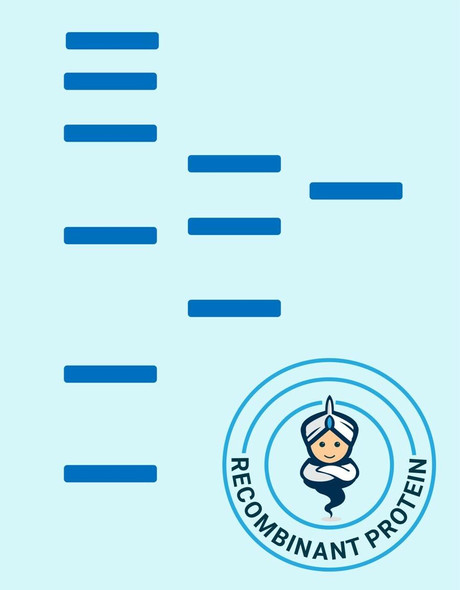Description
| Product Name: | Mouse BID Recombinant Protein |
| Product Code: | RPPB2891 |
| Size: | 10µg |
| Species: | Mouse |
| Target: | BID |
| Synonyms: | BH3-interacting domain death agonist, p22 BID, BID, FP497, MGC15319, MGC42355. |
| Source: | Escherichia Coli |
| Physical Appearance: | Sterile Filtered colorless liquid formulation. |
| Formulation: | The Mouse GST tag BID protein solution contains 10mM Tris-HCl pH-8, 1mM EDTA and 250mM NaCl. |
| Stability: | Store at 4°C if entire vial will be used within 2-4 weeks. Store, frozen at -20°C for longer periods of time.�For long term storage it is recommended to add a carrier protein (0.1% HSA or BSA).Avoid multiple freeze-thaw cycles. |
| Purity: | Greater than 95.0% as determined by: (a) Analysis by RP-HPLC.(b) Analysis by SDS-PAGE. |
BID is a pro-apoptotic Bcl-2 protein having only the BH3 domain. In reaction to apoptotic signaling, BID interacts with another Bcl-2 family of cell death regulators, called Bax, they form a heterodimer resulting to the insertion of Bax into the outer mitochondrial membrane. Bax induces the opening of the mitochondrial voltage-dependent anion channel which lead to the release of cytochrome c and other pro-apoptotic factors from the mitochondria resulting in activation of caspases. BID is a mediator of mitochondrial damage induced by caspase-8 (CASP8). CASP8 cleaves BID, and the COOH-terminal part translocates to mitochondria where it triggers cytochrome c release. The major proteolytic product p15 BID releasea cytochrome c. Isoform 1, Isoform 2 and Isoform 4 induce ice-like proteases and apoptosis while Isoform 3 does not induce apoptosis.
BID Mouse Recombinant produced in E.Coli is a single, non-glycosylated polypeptide chain containing 1-195 amino acids and having a molecular mass of 48 kDa.The Mouse BID is expressed as GST-Tag fusion protein and purified by proprietary chromatographic technique.
| UniProt Protein Function: | BID: a pro-apoptotic member of the Bcl-2 superfamily. Targets intracellular membranes and contains a BH3 death domain. Heterodimerizes with either the pro-apoptotic protein BAX or the anti-apoptotic protein BCL2, antagonizing its protective effect. The activity of BID is regulated by Caspase 8-mediated cleavage, exposing the BH3 domain and significantly changing the surface charge and hydrophobicity, causing translocation to mitochondria where it triggers cytochrome c release. Multiple alternatively spliced variants have been found. |
| UniProt Protein Details: | Protein type:Apoptosis; Mitochondrial Cellular Component: membrane; mitochondrion; cell; cytoplasm; intracellular; cytosol Molecular Function:protein binding; ubiquitin protein ligase binding Biological Process: caspase activation; release of cytochrome c from mitochondria; positive regulation of apoptosis; positive regulation of protein homooligomerization; apoptosis; DNA damage response, signal transduction; regulation of protein oligomerization; regulation of cell proliferation; regulation of apoptosis; positive regulation of protein oligomerization; apoptotic mitochondrial changes; protein targeting to mitochondrion; protein homooligomerization |
| UniProt Code: | P70444 |
| NCBI GenInfo Identifier: | 88984020 |
| NCBI Gene ID: | 12122 |
| NCBI Accession: | P70444.2 |
| UniProt Secondary Accession: | P70444,Q99M39, |
| UniProt Related Accession: | P70444 |
| Molecular Weight: | 21,952 Da |
| NCBI Full Name: | BH3-interacting domain death agonist |
| NCBI Synonym Full Names: | BH3 interacting domain death agonist |
| NCBI Official Symbol: | Bid�� |
| NCBI Official Synonym Symbols: | AI875481; AU022477; 2700049M22Rik�� |
| NCBI Protein Information: | BH3-interacting domain death agonist; p22 BID |
| UniProt Protein Name: | BH3-interacting domain death agonist |
| UniProt Synonym Protein Names: | p22 BID; BID |
| Protein Family: | Bidirectional sugar transporter |
| UniProt Gene Name: | Bid�� |
| UniProt Entry Name: | BID_MOUSE |






